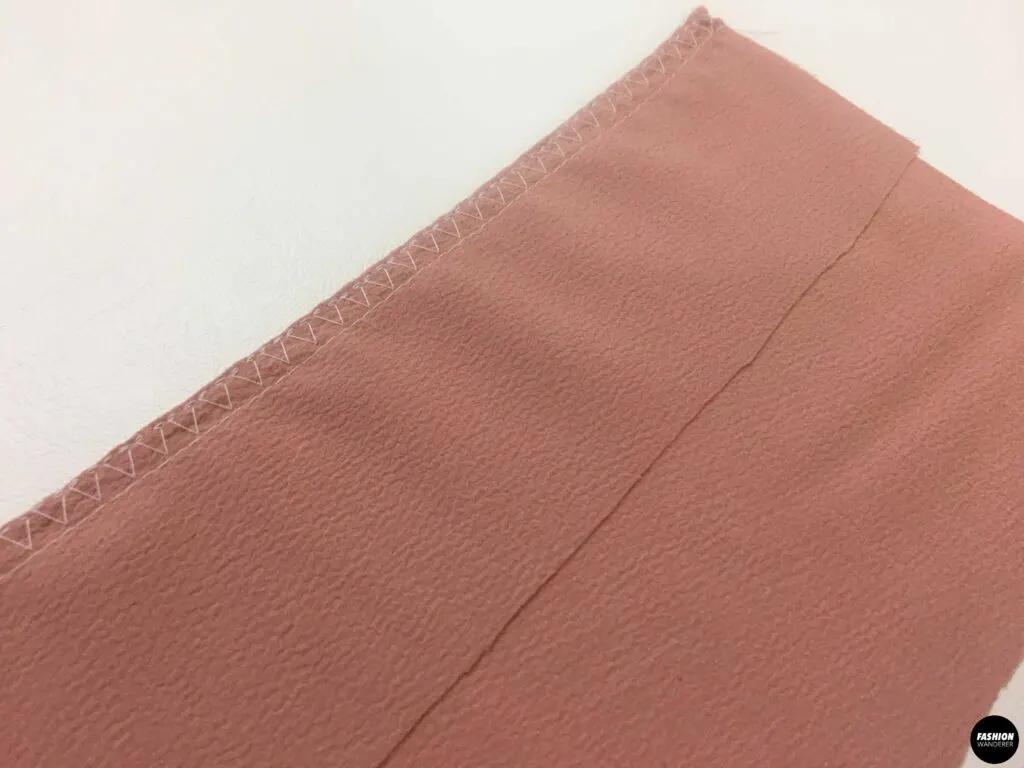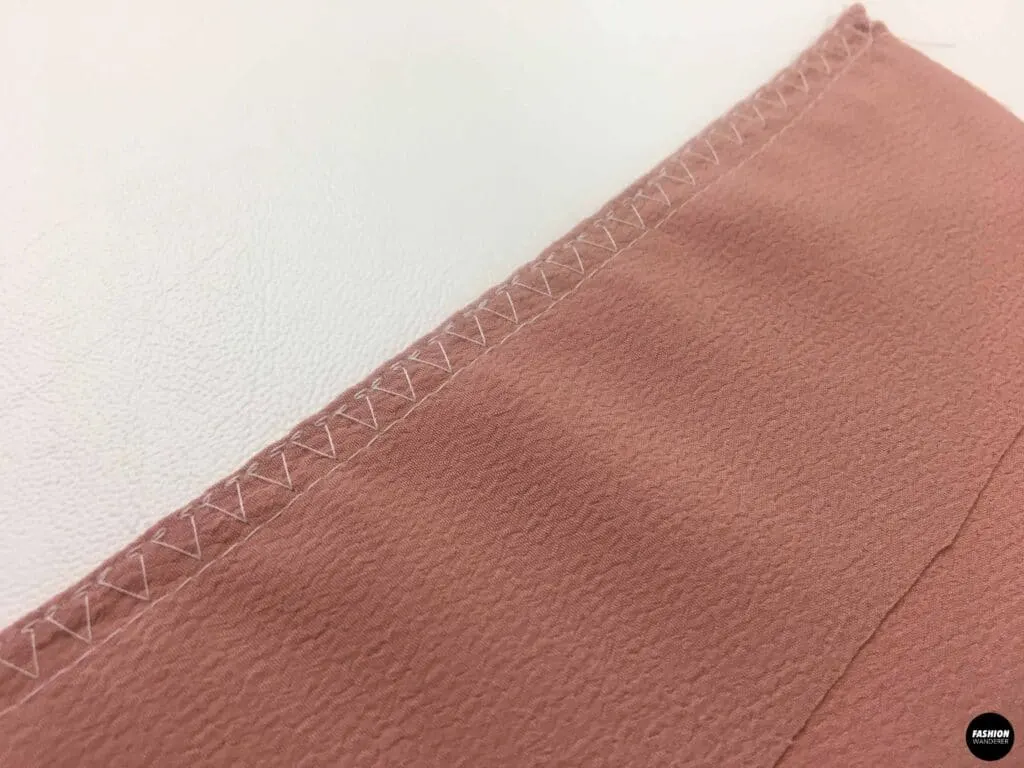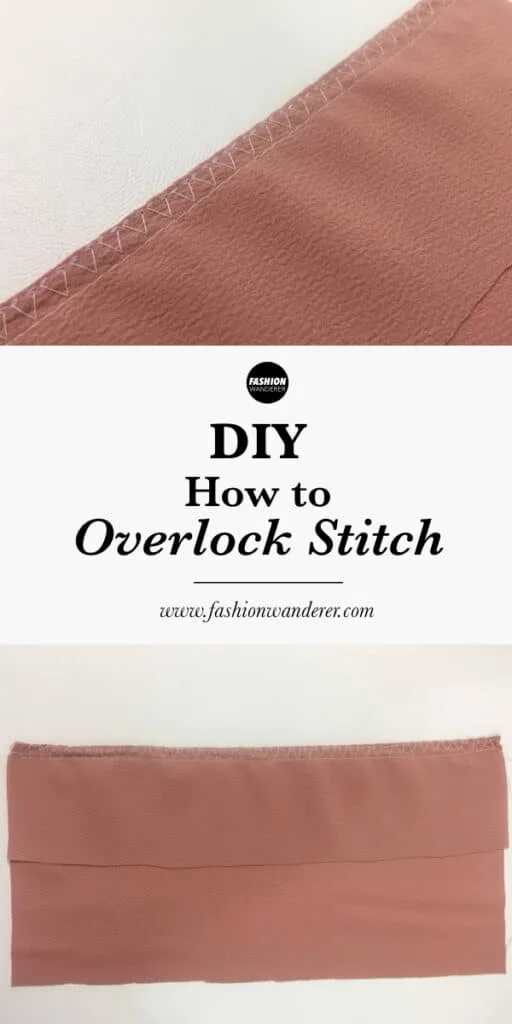Want to overlock stitch more professionally? From stitch settings to thread options, there are elements that affect accurate overlock stitches.
Whether you have sewing machine or serger, it is possible to sew overlook stitches on a garment by using a special foot and setting.
How to overlock stitch? Use an overlocking foot on a sewing machine and align the fabric edges against the guide. Choose an over-edge stitch or a wide zigzag stitch on the machine, and sew regular straight stitch on the seam allowance to give a clean finish.
An overlock stitch is one of the most common stitches incorporated on woven and knit fabric as it is a blend between zigzag and straight stitch. An overlocker shines when you can customize and control the dial settings, changing the settings gives you ultimate control to create lovely stitches.
What is overlocking stitch?
The overlocking stitch sews forwards and backwards in a straight line and sews a zigzag between each set of straight stitches. An overlock is a unique kind of stitch using a sewing machine that has higher elasticity.
As a result, this stitch does not unravel when there is a break in the thread. It gives a professional finish and is identical to serging as can be seen in store-bought clothes.
Doing it appropriately will give a stitch identical to serging, but does not require you owning overlocker machine.

When to Use an Overlock Stitch?
The best time to use an overlock stitch is to join two pieces of woven or stretch knit fabric together. Generally, this stitch sews over the pieces for seaming, edging and hemming.
However, a serger machine will cut the edges when they are fed through to give a clean cut edge to sew over.
An overlocker is capable of stitching 3, 4 or even 5 stitches simultaneously to achieve an intricate stitching. This should be used for joining seams and avoiding fraying due to the cut edge.
A serger machine always trims off the extra or frayed fabric with one smooth operation.
When using a regular sewing machine to overlock stitch, you can easily cut off the garment edges cleanly as you feed them through. It generates easy and quick finished seams.
The stitches created by an overlocker are versatile. Other than joining seams, you can use them for decoration, construction and reinforcement.
An overlock sewing machine is classified based on 1 to 5 thread stitches. The different number of stitches are used for:
- 1-thread: End to end or butt-seaming to finish fabrics.
- 2-thread: Edging and seaming for knits and woven including sewing elastic on lace, lingerie and hemming.
- 3-thread: Sewing pintucks or narrow rolled hems for knit and woven fabrics.
- 4-thread: Mock safety stitches, retaining flexibility and additional strength.
- 5-thread: Uses two needles to create safety stitch with a stronger seam.
Overlock stitch types
Generally overlock stitch vary based on how many threads are included in the machine. It provides different purpose and strength for each type of fabrication.
There are five types of overlock stitch. The different types of overlock stitching are dependent on the number of threads and stitch pattern.
The types overlock stitch include:
- Single:This is made of one thread and easily achievable with a regular Singer or Brother sewing machine. It is used for end to end, also known as butt-seaming, for textile finishing.
- Double: This is a common overall stitch used for stitching flatlock seams, edging woven fabrics, hemming, finishing seam edges, and attaching elastic or lace to garments.
- Triple:This type of overlock is employed for decorative edging. It is used for finishing the fabric edges, woven seams and knitted clothes. It can also sew pintucks and narrow rolled hems.
- 4-thread: This overlock stitch is very useful in seaming high-stress fabric parts. This is a stronger stitch and used for safety as it is flexible and ideal for both decorative edging and finishing.
- 5-thread: This is another safety stitch using 5-threads and 2-needles to make a 2-thread chain stitching with a 3-thread overlock stitch. It provides a strong seam for heavier fabrics like denim and terrycloth. There is no need for another straight stitch when using a 5-thread overlock stitch.
The different types of overlock stitches determine the kind of sewing techniques done on woven and knit fabrics. The number of threads and loops provide strength when joining two fabrics together or securing the raw edge.

How you can use a zigzag stitch with an overlocking stitch?
Use a zigzag stitch on a regular sewing machine to mimic an overlocking stitch. As a result, you can prevent the raw fabric edge from continuously fraying.
When done correctly, there would no longer be any fraying or unravelling of the fabric on the sides.
Follow these steps to use a zigzag stitch like an overlock stitch:
- Prepare the fabric by cutting clean cut line along the edge.
- Place the fabric below the sewing machine and then put the fabric edges near the sewing needle.
- Sew the fabric sides by switching the setting function to zigzag and changing to a special sewing machine foot. Set the zigzag to wide and length based on fabric preference or sewing instructions indicated.
- Sew the edge with the zigzag stitch so that it mimics an overlock stitch.
- Snap the thread ends and simply tie a knot to secure.
How to overlock stitch without a serger?
It is possible to make an overlock stitch even without a serger. The majority of the sewing machines come with a built-in overlocking function and various stitch type to replace with.
In addition, using a special foot function that directs the fabric and warping of the thread along the edge will improve the results.
There are three main presser feet used to create overlock stitch: zigzag foot, overcasting foot, and overage foot. It is important to use correct sewing machine needle for the fabric type you are working with, as the wrong needle and sewing foot may risk of breaking the needle or skipped stitches.
- Cut the raw edge close to the zigzag stitch to make a neat edge.
- Select the zigzag stitch on the sewing machine and set the stitch length between 2 and 3 and the stitch width 5 to start.
- Finish with straight stitch over the zigzag stitch to mimic the overlocker machine.
To accomplish overlock stitch on a regular sewing machine, use overage or overcast pressure foot for the best results. The special sewing machine feet help to stitch over raw edges very easily.
Also, it provides a straight stitch just off the raw edge with a crisscross stitch connecting the inner straight stitch.
The primary difference between the sewing machine and serger is that the edges are not trimmed prior to sewing. This has to be done manually by hand before beginning to sew.
Alter the sewing foot every time in an overlock function without a serger. Therefore, you can easily sew zigzag stitch or overlock stitch without a serger by using a regular sewing machine.

Sewing Overlock Stitch: Final Thoughts
Tosewoverlock stitch,either use a sewing machine with a special foot or use a serger. This stitch prevents fabric edges from fraying and unravelling, even when there is a cut in the stitch.
In addition, it blends straight line and zigzag stitch giving strength and a professional finish to the fabric edges.
Depending on the fabric, select the needle and thread accordingly. Find the proper stitch length and tension, and also change the sewing foot to overcast or zigzag foot.
If you are working with woven or non-stretch fabric, line up the two raw edges against the guide and sew. Afterwards, add straight stitch along the seam allowance to create a professional look and helps to secure the stitch even stronger.
For stretch knit fabrics, use stretch overcasting stitch and foot to stitch the seam and cut the raw edges. The stretch overcasting stitch is all you need to secure the seam without the need to add straight stitch.
If you are sewing a curved seam, stop every few stitches to pivot slightly and realign the edge of the fabric. Taking it slow will help to achieve the best result.
Overlocking lightweight fabric can be tough. For chiffon or organza fabric, overlock the seam allowance together, or use spray starch or seam tape to strengthen the seam to prevent it from being pulled into the feed dog.
Finishing the raw edges is a process that should not be skipped when sewing a garment. Use these sewing tips and techniques to apply overlock stitch whether you have sewing machine or serger, and you will achieve a professional looking finish on all your DIY clothing.
